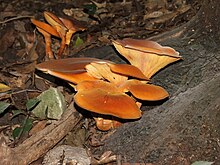| Omphalotus olearius | |
|---|---|

| |
| Scientific classification | |
| Domain: | Eukaryota |
| Kingdom: | Fungi |
| Division: | Basidiomycota |
| Class: | Agaricomycetes |
| Order: | Agaricales |
| Family: | Omphalotaceae |
| Genus: | Omphalotus |
| Species: | O. olearius
|
| Binomial name | |
| Omphalotus olearius | |
| Synonyms[1] | |

Omphalotus olearius,[2] commonly known as the jack-o'-lantern mushroom, is a poisonous orange gilled mushroom that to an untrained eye appears similar to some chanterelles. It is notable for its bioluminescent properties. It is found in woodland areas in Europe, where it grows on decaying stumps, on buried roots or at the base of hardwood trees. It has also been reported from the Western Cape Province, South Africa. A similar, but phylogenetically distinct[3] species found in eastern North America is Omphalotus illudens.
Unlike chanterelles, Omphalotus olearius and other Omphalotus species contain the toxin illudin S, and are poisonous to humans. While not lethal, consuming this mushroom leads to very severe cramps, vomiting, and diarrhea.